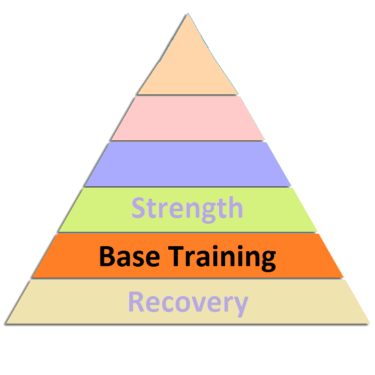Base training (also called the introductory or foundational training period) is the first phase of a training cycle. It’s what prepares runners for the more intense, race-specific workouts that come later.

Base Training Fundamentals
There are many goals for the base training phase of a training plan:
- Increase endurance – or a runner’s aerobic capacity
- Begin training the central nervous system
- Improve muscular strength to prevent injuries and prepare for the transition to workouts that build the desired speed and endurance
Priority number one is to gradually but steadily increase your running mileage. Other priorities of the introductory period include establishing a foundation of neuromuscular fitness with very small doses of maximal-intensity running and beginning the long process of developing efficiency and fatigue-resistance at race pace with small doses of running in the race-pace range.
There are three basic phases to a training cycle: base, strength, and speed. The problem that most athletes have is that they think theyare mutually exclusive. I think that the phase of training is defined by what you are focusing on during that phase.
But you always do a little of all of those things. There’s never a time of year when you’re just running mileage or you’re just doing speed. You’re always doing all of it, it’s just a matter of to what degree.
Before we get into the three main components of a well planned base phase of training, what do we notice?
- First, “endurance” is the main goal. This is prioritized by a focus on high mileage, building the long run, and mostly aerobic workouts.
- Second, base training is not just slow running! Workouts are always included – even quite fast sessions – but “fast” does not necessarily mean “hard.”
- Third, strength. You can get strong in a lot of ways:
Base Training Goal #1: Endurance
There are three fundamental ways to gain endurance:
- Run a lot (high mileage)
- Run long (the weekly long run)
- Run aerobic workouts (like a tempo workout)
Base training should include every one of these strategies. Mileage, or the total volume of a runner’s workload, is one of the best metrics for success. Simply put, the more you’re able to run, the faster you’re likely to race. But, most importantly, to safely build a strong aerobic engine, gradually increase mileage during the base phase of training.
Focus on three ways to increase total volume of running:
- Increasing the long run by about one mile every 1-2 weeks
- Adding 1-2 more runs per week over 2-3 months
- Adding 1-3 miles to weekday runs every 1-3 weeks
The end result should be a gradual, progressive increase in mileage that will help build endurance, injury resistance, and economy.
Run Long to Build the Aerobic Metabolism
The long run has become nearly synonymous with endurance. To increase stamina, increase the distance of the long run. A run where you are running easy and longer than 90 minutes has the following benefits:
- Denser mitochondria (the “energy factories” of your cells)
- Denser capillary networks to deliver oxygenated blood
- More mental toughness and resolve
- Improved muscular strength
- Enhanced running economy (efficiency)
- More energy efficient
No base phase is complete without long runs. No matter if you’re a miler or ultramarathoner, a veteran or a total beginner, the long run is an absolutely critical component to successful training. It is important to keep the long easy, conversational pace.
Aerobic Workouts
It’s a common misconception that base training doesn’t include any faster running. Aerobic workouts have you run at or slower than your lactate threshold (which is your tempo pace). Here are some good aerobic workouts:
- Progression runs where you gradually speed up to about tempo pace at the end of the run is a valuable early-season workout.
- Tempo runs improve your body’s tolerance to and ability to buffer lactate (the byproduct of anaerobic cellular respiration). In other words, you can hold a faster pace for longer.
- Fartlek workouts include pickups or surges of a few minutes with 1-3 minutes recovery. These are usually faster than the other two workouts mentioned, so use them only every 2-3 weeks during base training.
While aerobic workouts should make up the vast majority of your faster running, there should still be some speed sessions as well.
Base Training Goal #2: Neuromuscular Fitness
While they’re not the focus, neuromuscular workouts help maintain leg speed and neuromuscular fitness. There are three great ways to do this during base training:
- Run strides 2-3x per week
- Run hill sprints 1-2x per week or make one of your easy runs a hilly course
- Run fartlek workout every 2-3 weeks.
- Lift weights
Strides and hill sprints are best considered “drills” rather than “workouts.” They’re done in addition to your running Also, you don’t need to run more than two sessions of strides and hill sprints per week unless you are an advanced runners with a history of being able to stay healthy with a high level of intense training.
Finally, weight training makes the body stronger by stressing the central nervous system with resistance (weight), you can recruit a lot of muscle fibers in a safe way. Unlike maximal intensity sprinting, the injury risk is a lot lower. The effect becomes more efficient communication. Additionally, weight training builds strength in the small supporting muscles and connective tissue that help the body to move.
Base Training Goal #3: Muscular Strength
There are no fast, weak runners. Both lifting and running fast recruit a lot of muscle fibers – they “use more of the muscle,” which is more effective at building strength. Clearly, fast running and weight lifting should be included in base training – no matter if you’re preparing for a marathon or a mile. If you’re new to strength training, here’s a simple way to get started:
- Begin with bodyweight strength exercises
- Add resistance bands and medicine ball workouts after 1-2 months
- Finally, you’re ready to lift like the elites with a proper weight training program
Create the Perfect Base Phase
Just like a recipe, you now have all of the ingredients to plan an effective base training season:
- Gradually build your mileage and long run
- Run strides or hill sprints regularly
- Complete an aerobic workout every 7-14 days
- Run a faster fartlek workout every 10-14 days
- Include strength training to prevent injuries and tune the nervous system
When you combine higher mileage, increasing long runs, and smart workout progressions you’ll build a monster aerobic base that will propel you to new personal bests. You coach can design a proper plan comprised of these elements combine into a plan that will get you safely to your goals or higher! No time like now to get started…


